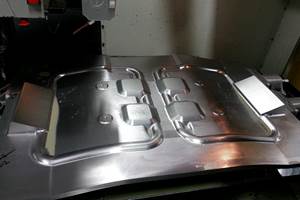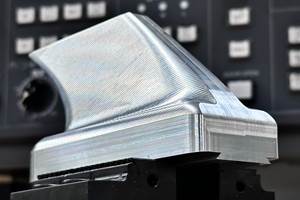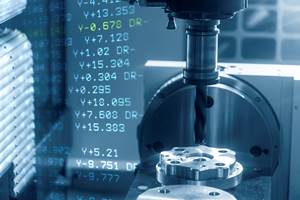Why Does My AM Part Cost So Much?
The machine, the facility and the material are just three costs behind the price tag.
Share





Last month, we started talking about the costs of additive manufacturing (AM) and why the slope of the “conventional” manufacturing cost curve decreases exponentially with increased production volume while the AM cost curve remains flat no matter how many units are produced. This month, we dig deeper into these costs to help better understand the economics behind AM.
• Machine cost and hourly usage rate: Machine costs are starting to decrease, but a single laser powder-bed fusion system with a typical build volume (10 by 10 by 12 inches) still costs between $400,000 and $800,000. These costs will continue to drop as multi-laser systems become more readily available, build volumes increase (for example, GE is working on a system with a cubic meter of build volume) and competition intensifies. Right now though, you are basically looking at $1 million by the time you add in all the ancillary equipment, explosion-proof vacuum, sieving station, filters, maintenance agreements and more.
Assuming three- to five-year depreciation of the machine and utilization rates between 70 to 90 percent, machine usage costs about $30 to $50 per hour, not including overhead. It does not matter whether you are additively manufacturing a part in house or outsourcing it: You will incur substantial charges for machine time.
My fastest build was about 17 hours, and my longest build was 100 hours. You can do the math to figure out how much those parts cost me to make on our machine. This does not even factor in operator cost, which could easily range from $80 to $100 or more per hour for a skilled technician to set up the machine, remove the build, etc.
• Facility and support costs: If you are bringing AM in house, then retrofitting your facility to accommodate an AM system, particularly one running Ti-6Al-4V and AlSi10Mg, can easily cost $250,000 or more to upgrade fire-suppression systems (water sprinklers are not effective with metal fires; in fact, they make matters worse); add Class D fire extinguishers; and install electrostatic flooring and humidity- and temperature-controlled spaces for storing powders.
Machine operators will need proper personal protection equipment for handling metal powders, setting up machines for AM builds, removing parts and more. They will also need a medical exam and training before they can use a negative-pressure respirator, which is why many facilities and AM training programs are using positive-pressure respirators, even though they are considerably more expensive.
Facility-wise, you will also need to think about additional equipment for post processing, such as an oven/furnace, wire EDM, cleaning equipment and more, if you want to do everything in house. (For more detail on machine installation and setup, I recommend reading the five-part series by Dhruv Bhate, who documented the process at (PADT).
• Material cost: Many AM cost models for powder-bed fusion systems struggle here: Do you charge just for the powder to make the part(s) or do you charge for the powder to fill the whole build volume? If it is your machine, then you have to buy enough powder to fill the entire build volume, not just the material needed for the part itself.
The accompanying figure shows my first blunder at this. We were building about $200 worth of tensile bars for a sponsor and decided to orient a few test specimens in the vertical (Z) direction to evaluate the differences in mechanical properties. The amount of material need to make the bars did not change, but the build volume certainly did because powder-bed fusion requires filling the entire build volume to the build height, no matter how big or small your parts are. In the end, I had to buy $5,000 worth of powder to make $200 worth of test specimens—a mistake I hopefully only make once.
The cost of powder itself can range from $80 to $120 per kilogram for AlSi10Mg or stainless steel 316L and from $300 to $600 for Ti-6Al-4V from the original equipment manufacturer (OEM) that sold the AM machine. Yes, you can buy the same powder from other suppliers cheaper, and companies like LPW Technology are working hard to drive costs down, but you need to be sure to read the fine print when you buy your AM system to see what using non-OEM powder does to your system’s warranty. Also, can you reuse the powder that is left after the build? Some companies say you can indefinitely, others cap it at 10 times and still others say it depends on the powder. The jury is still out, but even if the powder is reused, the value of that powder depreciates as it is reused. Rarely do companies take this into account despite the significant impact it can have on the material cost for a given build.
So how much do you end up paying for your material? If you are running your system in house, then you have to buy enough new powder to fill the whole volume or supplement your reused powder. If you are working with an AM service bureau, you will need to specify exactly what you want in terms of material. Most will quote you only for the material in the part, but they are likely reusing powder. If you want new powder, you will likely pay full freight for the whole volume. Either way, it is an expensive proposition given the current cost of metallic-powder feedstock.
Finally, as if this isn’t enough, your parts are not “done” when they are finished printing. You still have to post process your parts (stress relieve, heat treat, machine, finish, clean, inspect, etc.), which usually takes longer, and costs more, than the actual additive manufacturing process. AM is not as easy as many people are led to believe.Related Content
4 Tips for Staying Profitable in the Face of Change
After more than 40 years in business, this shop has learned how to adapt to stay profitable.
Read MoreCustom Workholding Principles to Live By
Workholding solutions can take on infinite forms and all would be correct to some degree. Follow these tips to help optimize custom workholding solutions.
Read MoreTips for Designing CNC Programs That Help Operators
The way a G-code program is formatted directly affects the productivity of the CNC people who use them. Design CNC programs that make CNC setup people and operators’ jobs easier.
Read More2 Secondary Coordinate Systems You Should Know
Coordinate systems tell a CNC machine where to position the cutting tool during the program’s execution for any purpose that requires the cutting tool to move.
Read MoreRead Next
Last Chance! 2025 Top Shops Benchmarking Survey Still Open Through April 30
Don’t miss out! 91ÊÓƵÍøÕ¾ÎÛ's Top Shops Benchmarking Survey is still open — but not for long. This is your last chance to a receive free, customized benchmarking report that includes actionable feedback across several shopfloor and business metrics.
Read MoreAMRs Are Moving Into Manufacturing: 4 Considerations for Implementation
AMRs can provide a flexible, easy-to-use automation platform so long as manufacturers choose a suitable task and prepare their facilities.
Read MoreMachine Shop MBA
Making Chips and 91ÊÓƵÍøÕ¾ÎÛ are teaming up for a new podcast series called Machine Shop MBA—designed to help manufacturers measure their success against the industry’s best. Through the lens of the Top Shops benchmarking program, the series explores the KPIs that set high-performing shops apart, from machine utilization and first-pass yield to employee engagement and revenue per employee.
Read More






















